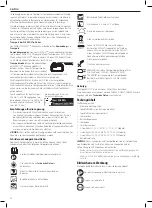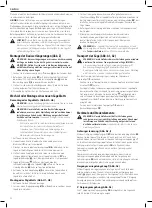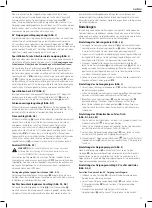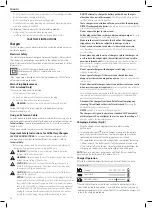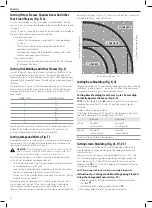
43
EnGLIsh
Residual Risks
The following risks are inherent to the use of saws:
• Injuries caused by touching the rotating parts.
In spite of the application of the relevant safety regulations and the
implementation of safety devices, certain residual risks cannot be avoided.
These are:
• Impairment of hearing.
Additional Safety Rules for Mitre Saws
WARNING:
Do not connect to the mains power supply into the unit
until complete instructions are read and understood.
•
DO NOT OPERATE THIS MACHINE
until it is completely assembled and
installed according to the instructions. A machine incorrectly assembled
can cause serious injury.
•
OBTAIN ADVICE
from your supervisor, instructor, or another qualified
person if you are not thoroughly familiar with the operation of this
machine. Knowledge is safety.
•
MAKE CERTAIN
the blade rotates in the correct direction. The teeth on the
blade should point in the direction of rotation as marked on the saw.
•
TIGHTEN ALL CLAMP HANDLES,
knobs and levers prior to operation.
Loose clamps can cause parts or the workpiece to be thrown at
high speeds.
•
BE SURE
all blade and blade clamps are clean, recessed sides of blade
clamps are against blade and arbour screw is tightened securely. Loose or
improper blade clamping may result in damage to the saw and possible
personal injury.
•
DO NOT OPERATE ON ANYTHING OTHER THAN THE DESIGNATED
VOLTAGE
for the saw. Overheating, damage to the tool and personal
injury may occur.
•
DO NOT WEDGE ANYTHING AGAINST THE FAN
to hold the motor
shaft. Damage to tool and possible personal injury may occur.
•
NEVER CUT METALS
or masonry. Either of these can cause the carbide
tips to fly off the blade at high speeds causing serious injury.
•
NEVER HAVE ANY PART OF YOUR BODY IN LINE WITH THE PATH OF
THE SAW BLADE.
Personal injury will occur.
•
NEVER APPLY BLADE LUBRICANT TO A RUNNING BLADE.
Applying
lubricant could cause your hand to move into the blade resulting in
serious injury.
•
DO NOT
place either hand in the blade area when the saw is connected to
the power source. Inadvertent blade activation may result in serious injury.
•
NEVER REACH AROUND OR BEHIND THE SAW BLADE.
A blade can
cause serious injury.
•
DO NOT REACH UNDERNEATH THE SAW
unless it is unplugged and
turned off. Contact with saw blade may cause personal injury.
•
SECURE THE MACHINE TO A STABLE SUPPORTING SURFACE.
Vibration can possibly cause the machine to slide, walk, or tip over,
causing serious injury.
•
USE ONLY CROSSCUT SAW BLADES
recommended for mitre saws.
For best results, do not use carbide tipped blades with hook angles in
excess of 7 degrees. Do not use blades with deep gullets. These can deflect
and contact the guard, and can cause damage to the machine and/or
serious injury.
•
USE ONLY BLADES OF THE CORRECT SIZE AND TYPE
specified for this
tool to prevent damage to the machine and/or serious injury (complying
with EN847-1).
•
INSPECT BLADE FOR CRACKS
or other damage prior to operation. A
cracked or damaged blade can come apart and pieces can be thrown at
high speeds, causing serious injury. Replace cracked or damaged blades
immediately. Observe the maximum speed marked on the saw blade.
•
THE MAXIMUM SPEED OF THE SAW BLADE
shall always be greater
than or at least equal to the speed marked on the rating plate of the tool.
•
THE SAW BLADE DIAMETER
must be in accordance with the markings
on rating plate of the tool.
•
CLEAN THE BLADE AND BLADE CLAMPS
prior to operation. Cleaning
the blade and blade clamps allows you to check for any damage to the
blade or blade clamps. A cracked or damaged blade or blade clamp
can come apart and pieces can be thrown at high speeds, causing
serious injury.
•
DO NOT USE WARPED BLADES.
Check to see if the blade runs true and
is free from vibration. A vibrating blade can cause damage to the machine
and/or serious injury.
•
DO NOT
use lubricants or cleaners (particularly spray or aerosol) in the
vicinity of the plastic guard. The polycarbonate material used in the guard
is subject to attack by certain chemicals.
•
KEEP GUARD IN PLACE
and in working order.
•
ALWAYS USE THE KERF PLATE AND REPLACE THIS PLATE WHEN
DAMAGED.
Small chip accumulation under the saw may interfere with
the saw blade or may cause instability of workpiece when cutting.
•
USE ONLY BLADE CLAMPS SPECIFIED FOR THIS TOOL
to prevent
damage to the machine and/or serious injury.
•
MAKE SURE
to use the correct saw blade for the material to be cut.
•
CLEAN THE MOTOR AIR SLOTS
of chips and sawdust. Clogged motor
air slots can cause the machine to overheat, damaging the machine and
possibly causing a short which could cause serious injury.
•
NEVER LOCK THE SWITCH IN THE “ON” POSITION.
Severe personal
injury may result.
•
NEVER STAND ON TOOL.
Serious injury could occur if the tool is tipped or
if the cutting tool is unintentionally contacted.
WARNING:
Cutting plastics, sap coated wood, and other materials
may cause melted material to accumulate on the blade tips and the
body of the saw blade, increasing the risk of blade overheating and
binding while cutting.
WARNING: Always wear proper personal hearing protection.
Under some conditions and duration of use, noise from this product
may contribute to hearing loss. Be aware of the following factors
influencing exposure to noise:
• Use saw blades designed to reduce the emitted noise,
• Use only well sharpened saw blades, and
• Use specifically designed noise-reduction saw blades.
WARNING: ALWAYS
use safety glasses. Everyday eyeglasses are NOT
safety glasses. Also use face or dust mask if cutting operation is dusty.
WARNING:
Use of this tool can generate and/or disperse dust, which
may cause serious and permanent respiratory or other injury.
WARNING:
Some dust created by power sanding, sawing, grinding,
drilling, and other construction activities contains chemicals known to
cause cancer, birth defects or other reproductive harm. Some examples
of these chemicals are:
• lead from lead-based paints,
• crystalline silica from bricks and cement and other masonry
products, and
• arsenic and chromium from chemically-treated lumber.
Your risk from these exposures varies, depending on how often you do this type
of work. To reduce your exposure to these chemicals: work in a well ventilated
area, and work with approved safety equipment, such as those dust masks
that are specially designed to filter out microscopic particles.
•
Avoid prolonged contact with dust from power sanding, sawing,
grinding, drilling, and other construction activities.
Wear protective
clothing and wash exposed areas with soap and water. Allowing dust to
get into your mouth, eyes, or lay on the skin may promote absorption of
harmful chemicals.
WARNING:
Use of this tool can generate and/or disperse dust, which
may cause serious and permanent respiratory or other injury. Always
use approved respiratory protection appropriate for the dust exposure.
Summary of Contents for DCS727
Page 1: ...Final Page Size 172 x 240 mm DCS727 ...
Page 4: ...2 Fig D Fig C Fig B Fig E Fig F 41 42 5 4 61 4 5 39 68 40 36 ...
Page 5: ...3 Fig G Fig H4 Fig I Fig H1 Fig H2 Fig H3 1 44 1 43 31 21 22 19 51 49 50 46 43 45 31 48 47 ...
Page 6: ...4 Fig N Fig O1 Fig L Fig M Fig K 21 21 60 62 Fig J 10 59 52 53 54 55 56 57 58 ...
Page 7: ...5 Fig O2 Fig Q Fig S Fig P Fig T Fig R 2 1 A 1 2 ...
Page 8: ...6 Fig X1 Fig W1 Fig W1 Fig V2 Fig V1 13 46 17 13 46 13 13 17 Fig U ...
Page 9: ...7 Fig X2 Fig Y Fig AA Fig Z 1 63 64 15 16 66 65 67 ...


